
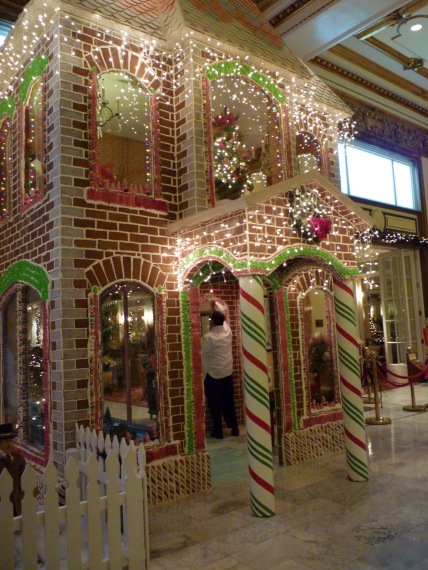
“The great gingerbread war has heated up in San Francisco, and it all comes down to one eternal question: Is it a gingerbread house if you can’t eat it?” So asked an article in the Chronicle newspaper a few years ago. Just as I also wondered this morning, when I heard from two young women who for years have used a hot glue gun to put theirs together. I had never heard of such a thing. Their children have started asking when they can eat the house, and the mothers remind them that they always only eat loose candy while they are assembling it.
At our house, we’ve had two gingerbread construction events that I can remember. I wasn’t the instigator. I prefer to provide background support in the form of dishwashing and photography, because cake and icing have always seemed like the most unlikely media for art or architecture, and near certain failure doesn’t sound like fun.
These first photos are from 25 + years ago, when young people could do things solely for fun without having to spend time on their phones taking pictures to share worldwide. My kids and their friends were making two houses, and one never would stay standing. I think the siding was hopelessly warped from being baked on a thin cookie sheet.

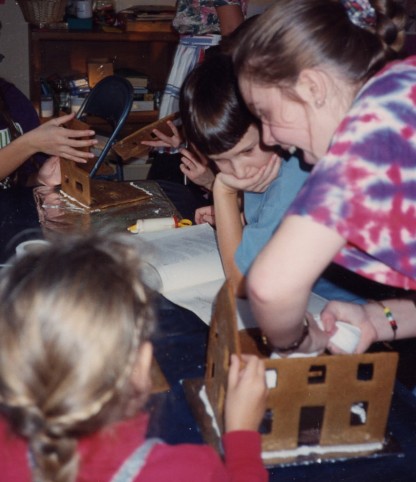

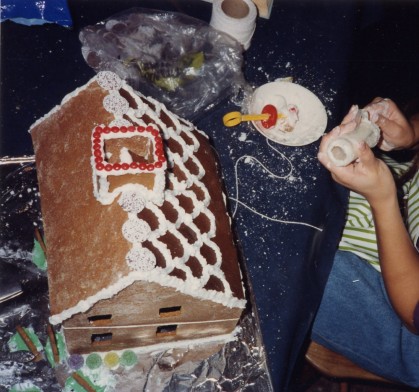

In San Francisco, it’s been traditional for the chefs at the Fairmont Hotel to make their large Christmas gingerbread house (top picture) out of completely edible components. Because a gingerbread house is the last thing that should be purely symbolic, right? When my friends and I had a tradition for a few years, of a trip to San Francisco at Christmastime, we appreciated being able to break off pieces of the house to eat. Nibbling was discouraged, true, but every day the house was quietly repaired, and sometimes a repairman chef would hand a child a piece of candy from his kit in hopes that it might mean one less candy cane broken off.
 “Go ahead, have a piece,” said Tom Klein, Fairmont hotel’s regional vice president and general manager. He was handing out gingerbread shingles to startled hotel guests in the lobby. Technically, eating the Fairmont’s walk-through gingerbread house is not allowed, but Klein had a point to make about the edibility of the building materials, and the kids he was handing the gingerbread to were not complaining.
“Go ahead, have a piece,” said Tom Klein, Fairmont hotel’s regional vice president and general manager. He was handing out gingerbread shingles to startled hotel guests in the lobby. Technically, eating the Fairmont’s walk-through gingerbread house is not allowed, but Klein had a point to make about the edibility of the building materials, and the kids he was handing the gingerbread to were not complaining.
“Meanwhile, at the St. Francis, its fanciful baked house was more of a medieval castle, lavishly and intricately decorated by chefs with tweezers. It’s a smaller, more intricate creation, exhibited behind a sturdy metal fence designed to keep grubby little fingers at bay.”
I have seen the St. Francis castle, too, but I don’t think I knew that it was gingerbread. I read that they recycle the gingerbread from previous houses to make it; that would seem to make it inedible right there. On the other hand, I liked getting a whiff of the Fairmont gingerbread:

I’m not saying that the mothers mentioned above were aiming for Instagram perfection. Probably they just feel the way I do about my Christmas cookies; I enjoy the creative project and like doing it alone. And if a recipe calls for a really messy or difficult ingredient, I just won’t use it. That’s why I don’t make gingerbread houses. Even the most precise and well thought out ones, with slabs of sturdy cake baked on unwarped cookie sheets, must be accepted as “the best we could do with the materials.” Here are my pictures of the more recent one built in my house, spearheaded by Pippin and the Professor.
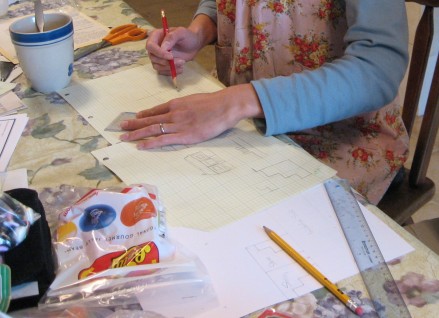



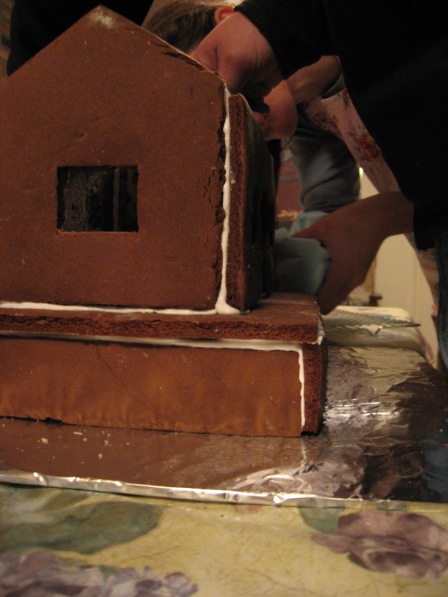
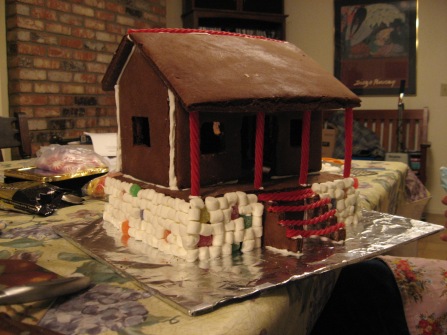

This year the gingerbread house at the Fairmont is bigger than ever, and you may rent it for “private” dining. Up to ten people can sit at table inside, starting at $300 for two hours. I’m really curious about who will be enjoying that luxury. (It doesn’t sound appealing to me, to be on display to every holiday gawker passing through the opulent lobby, while partaking of such a gimmick.) The population of San Francisco is notoriously low on children, but maybe some well-to-do ladies will stop by with their grandchildren on the way back from seeing “The Nutcracker.”
I do love everything about edible gingerbread houses — their colorful and aromatic, candy-laden selves, and their fairy-tale connections — as long as other people are building them. How unlikely! How extravagant and wild. My style is to let the people get old enough to want to try culinary architecture on their own, and to have the patience to see the project through to the end; until then, I’m happy to make a mess in the kitchen with children of any age, baking gingerbread cookies. And when they’ve had enough of that, and run off after a while, I will also love finishing up on my own!
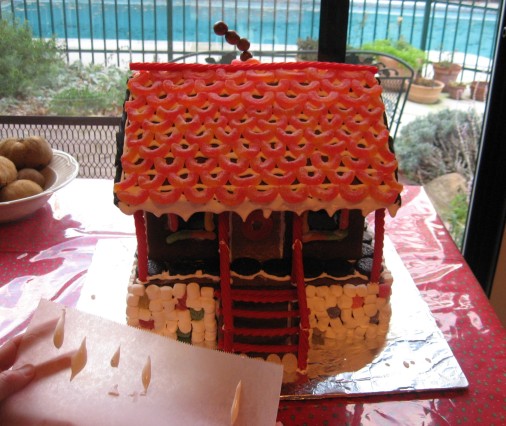
From this house, what I’d like is a few puffs of malt-ball smoke. ❤

 My daughter Pearl’s thankful husband posted pictures of her, from 1999, 2009, and this year, and they are stunning to me, as they not only show how she has become more beautiful with every decade, but hint that her beauty flows from some of that liberty that this poem explores, and it shines out from her countenance as peace and joy.
My daughter Pearl’s thankful husband posted pictures of her, from 1999, 2009, and this year, and they are stunning to me, as they not only show how she has become more beautiful with every decade, but hint that her beauty flows from some of that liberty that this poem explores, and it shines out from her countenance as peace and joy.














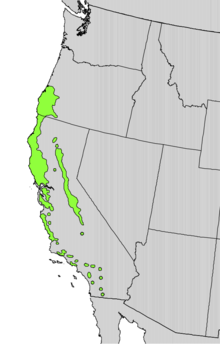




 When my Landscape Lady suggested Delta Sunflowers for my front garden, she said they would reseed themselves year after year. Those in her own garden have done that, and she gave me my original plants from her excess of volunteers when they came up in May of 2017. My plants did make their own starts in succeeding springtimes, but not very many, which I think has something to do with the thick bark mulch. The seedlings that did emerge were not in the right places, so I had to transplant them.
When my Landscape Lady suggested Delta Sunflowers for my front garden, she said they would reseed themselves year after year. Those in her own garden have done that, and she gave me my original plants from her excess of volunteers when they came up in May of 2017. My plants did make their own starts in succeeding springtimes, but not very many, which I think has something to do with the thick bark mulch. The seedlings that did emerge were not in the right places, so I had to transplant them.



